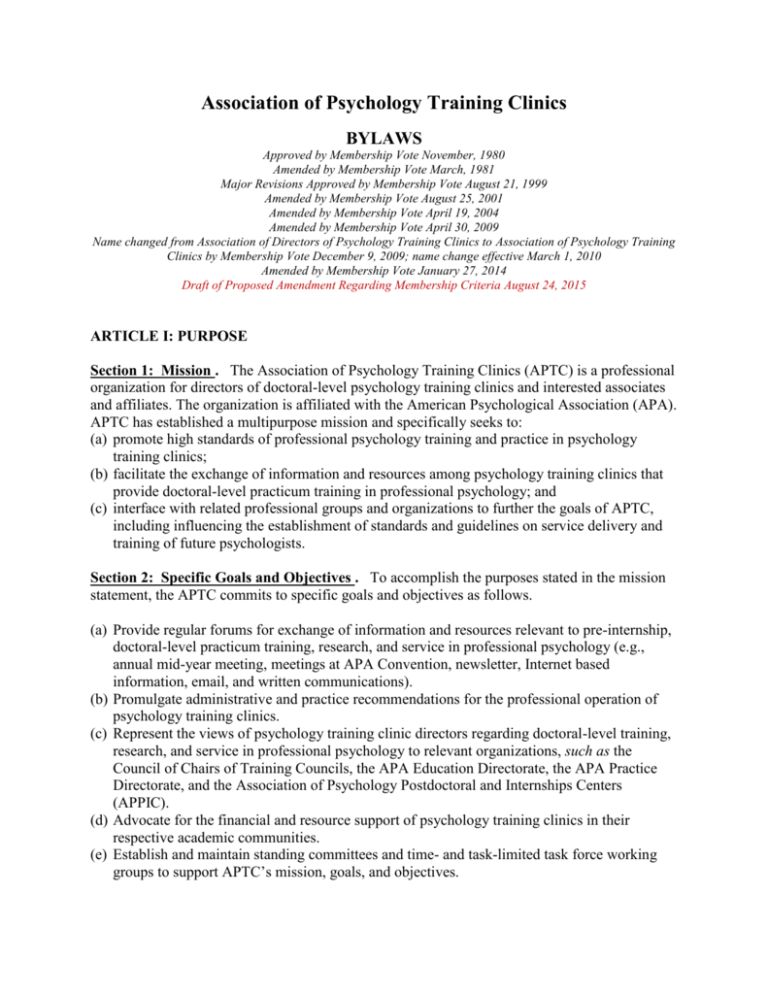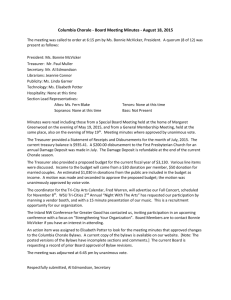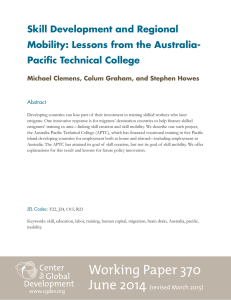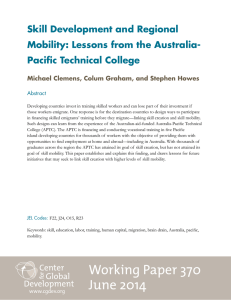Association of Directors of Psychology Training Clinics
advertisement

Association of Psychology Training Clinics BYLAWS Approved by Membership Vote November, 1980 Amended by Membership Vote March, 1981 Major Revisions Approved by Membership Vote August 21, 1999 Amended by Membership Vote August 25, 2001 Amended by Membership Vote April 19, 2004 Amended by Membership Vote April 30, 2009 Name changed from Association of Directors of Psychology Training Clinics to Association of Psychology Training Clinics by Membership Vote December 9, 2009; name change effective March 1, 2010 Amended by Membership Vote January 27, 2014 Draft of Proposed Amendment Regarding Membership Criteria August 24, 2015 ARTICLE I: PURPOSE Section 1: Mission . The Association of Psychology Training Clinics (APTC) is a professional organization for directors of doctoral-level psychology training clinics and interested associates and affiliates. The organization is affiliated with the American Psychological Association (APA). APTC has established a multipurpose mission and specifically seeks to: (a) promote high standards of professional psychology training and practice in psychology training clinics; (b) facilitate the exchange of information and resources among psychology training clinics that provide doctoral-level practicum training in professional psychology; and (c) interface with related professional groups and organizations to further the goals of APTC, including influencing the establishment of standards and guidelines on service delivery and training of future psychologists. Section 2: Specific Goals and Objectives . To accomplish the purposes stated in the mission statement, the APTC commits to specific goals and objectives as follows. (a) Provide regular forums for exchange of information and resources relevant to pre-internship, doctoral-level practicum training, research, and service in professional psychology (e.g., annual mid-year meeting, meetings at APA Convention, newsletter, Internet based information, email, and written communications). (b) Promulgate administrative and practice recommendations for the professional operation of psychology training clinics. (c) Represent the views of psychology training clinic directors regarding doctoral-level training, research, and service in professional psychology to relevant organizations, such as the Council of Chairs of Training Councils, the APA Education Directorate, the APA Practice Directorate, and the Association of Psychology Postdoctoral and Internships Centers (APPIC). (d) Advocate for the financial and resource support of psychology training clinics in their respective academic communities. (e) Establish and maintain standing committees and time- and task-limited task force working groups to support APTC’s mission, goals, and objectives. APTC Bylaws Page 2 (f) Promote ethical and legal standards of professional psychology training, supervision, service delivery, applied research, and administration as mandated by federal and state laws, Ethical Principles of Psychologists and Code of Conduct (2002), and other publications of standards for professional psychologists. (g) Recognize and support a full range of activities in psychology training clinics, including graduate level training, service delivery, research, and community outreach in the specialty areas of clinical, clinical child, community, counseling, health, and school psychology. ARTICLE II: MEMBERSHIP Section 1: Members. Full APTC membership (“Members”) is open to directors of psychology training clinics associated with doctoral-level graduate training programs in professional psychology (i.e., clinical, clinical child and adolescent, community, counseling, health, and school psychology) at regionally accredited universities. Members, typically in a university faculty position, are directors in clinics that focus on training Ph.D., Psy.D., or Ed.D. graduate students, who are supervised by doctoral-level clinic supervisors. In addition, a training program may select a faculty member to represent the program to APTC in the temporary absence of a training clinic director. Membership as an Associate Member is open to former APTC Members, current Training Directors of clinical, clinical child, community, counseling, health, or school psychology doctoral-level training programs, Associate or Assistant Clinic Directors, or others at the discretion of the Executive Committee. Membership as an Emeritus Member is open to former APTC Members with a long-standing commitment to APTC, who petition (and receive from) the Executive Committee for Emeritus membership. Directors of university-based, training-focused clinics affiliated with graduate programs in professional psychology at universities outside the U.S. and Canada may join as International Affiliates, provided the program grants the highest degree in the field for that nation. Section 2: Dues. Members, Associate Members, Emeritus Member, and International Affiliates are required to pay annual dues as established and monitored by the APTC Executive Committee to remain in good standing. Section 3: Member Privileges. Members in good standing may vote on all matters brought to the APTC membership and may serve, if elected or appointed, on the Executive Committee, standing committees, or task force working groups. Emeritus Members, Associate Members, and International Affiliates do not have voting privileges, but may serve on standing committees and task force working groups if authorized by the Executive Committee. ARTICLE III: GOVERNANCE Section 1: Executive Committee. The APTC is governed by an Executive Committee composed of an Immediate Past President, President, President-Elect, Secretary, Treasurer, and three Members-at-Large, one of which is an Early Career Psychologist (within 10 years of earning the doctoral degree). Members in good standing may be nominated and elected to serve as President, Secretary, or Member-at-Large for a 2-year term or Treasurer for a 4-year term. A single term is defined as beginning at the membership business meeting held in conjunction with APTC Bylaws Page 3 the annual APTC mid-year meeting in a given year and ends at the same business meeting two years later or four years later for Treasurer. Section 2: Nomination and Election Procedures. The Executive Committee is responsible for maintaining a nomination procedure that is disseminated to membership by 90 days prior to the APTC mid-year meeting of a given year. Nominated individuals must be notified of their nomination and agree to attend annual mid-year meetings during their proposed term of office (i.e., two years for Secretary, and Member-at-Large, four years for Treasurer, six years for President, inclusive of terms as President-Elect and Immediate Past President). The Executive Committee is responsible for maintaining an election procedure that is disseminated to membership. A simple majority of all votes cast 60 days prior to the APTC mid-year meeting of a given year will determine election to each of the Executive Committee positions receiving nominations. Elected individuals will assume their responsibilities at the membership business meeting held at the annual APTC mid-year meeting, typically held in late winter to spring each year. If an Immediate Past President resigns or is incapacitated, the other Executive Committee officers will, by simple majority vote, elect a successor from the Executive Committee to serve the remainder of the departing officer’s term. If a President-Elect, President, Secretary, Treasurer, or Member-at-Large officer resigns or is incapacitated, the other Executive Committee officers will, by simple majority vote, elect a successor from the membership to serve until the next annual nomination period, when nomination and election procedures provide an avenue to fill the position. Section 3: Executive Committee Responsibilities . The Executive Committee is jointly responsible for overseeing all APTC activities and obligations. The Executive Committee, through consensus, distributes specific responsibilities among its officers on a year-to-year basis. The Executive Committee has the authority to establish standing committees and task force working groups and to appointment chairpersons to these entities. The need for each standing committee and task force working group is reviewed, and continuance voted on, by the Executive Committee during the mid-year meeting. Standing committees may include, but not be limited to Awards and Recognition, Bylaws and Documents, Collaboration and Liaison, Council of Past Presidents, Diversity, Membership and Resources, New Director Support, Programs and Conferences, Publications and Public Relations, Research, and Supervision. The President presides over Executive Committee meetings, the annual business meeting, and the mid-year meeting or authorizes a representative to do so and appoints chair positions on standing committees and task force working groups. The Treasurer is responsible for maintaining a system for management of dues collected and owed by Members, Associate Members, and International Affiliates, filing an annual IRS tax return, and providing appropriate information to banking and credit card processing entities. The President and Treasurer are jointly responsible for authorizing APTC expenditures and recording income and expenses. The Treasurer provides a report of APTC finances at the annual business meeting during the mid-year meeting or within two weeks of receiving a request from another Executive Committee officer at other times of the year. APTC Bylaws Page 4 The Secretary is responsible for formal correspondence with APA and other organizations, as directed by the Executive Committee, for documenting the proceedings of Executive Committee and general membership meetings and providing a report of these proceedings to membership. The Secretary, in collaboration with the Treasurer, is also responsible for maintaining a system for managing records of membership status in the organization. Each Member-at-Large (three positions), the Immediate Past President, and the President-Elect chairs a standing committee or task force working group and provides leadership for activities associated with that committee or working group. The President appoints each of these Executive Committee Members to chair a committee or working group or each can request specific leadership responsibilities for their respective terms. Policies and procedures established by the Executive Committee are presented to members attending the annual business meeting and via written and electronic communications, with opportunities given for discussion and debate. The Executive Committee is obligated to present to the APTC membership major policy and procedure changes and substantive increases in dues at regularly scheduled meetings and in electronic or written communications at other times of the year. A timeline and procedure for voting on major policy and procedure changes and substantive increases in dues is given to members at the time information is presented to them. A simple majority of Members casting votes settles the specific issue under consideration. ARTICLE IV: BYLAW AMENDMENTS, ALTERATIONS, AND REVIEW Section 1: Amendments. Executive Committee officers may propose amendments or alterations to APTC Bylaws. Members also may propose Bylaws amendments or alterations for consideration by the Executive Committee. Proposed Bylaws changes are approved, by a simple majority vote of the Executive Committee, to be voted on by Members. Approved Bylaw change proposals are presented to members, with voting procedures being made explicit at the time of presentation. Membership opinions and feedback will be solicited via written or electronic communications prior to the date of a vote. A simple majority of Members casting votes is required to ratify and formally amend the Bylaws. Section 2: Review. The Executive Committee reviews APTC Bylaws at a minimum of every five years. Amendments or alterations to bylaws deemed necessary must comply with the process described in Section 1 of this article (IV).











